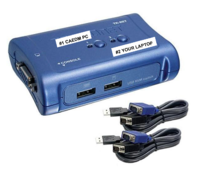| Line 1: | Line 1: | ||
[[File:KVM_switch.png|200px|thumb|right]] | [[File:KVM_switch.png|200px|thumb|right]] | ||
| − | A '''KVM switch''' (KVM being an abbreviation for "keyboard, video and mouse") is a hardware device that allows a user to control multiple computers from a single keyboard, monitor and mouse. | + | A '''KVM switch''' (KVM being an abbreviation for "keyboard, video and mouse") is a hardware device that allows a user to control multiple computers from a single keyboard, monitor and mouse. KVM switches can be found in group cubicles and allow users to quickly transition between a ThinClient and a user's laptop. |
'''To use''', attach available monitor and USB connections to a laptop. Once connected, press buttons labeled "#1 CAEDM PC" and "#2 YOUR LAPTOP" to switch between the two devices. | '''To use''', attach available monitor and USB connections to a laptop. Once connected, press buttons labeled "#1 CAEDM PC" and "#2 YOUR LAPTOP" to switch between the two devices. | ||
Latest revision as of 15:31, 8 August 2018
A KVM switch (KVM being an abbreviation for "keyboard, video and mouse") is a hardware device that allows a user to control multiple computers from a single keyboard, monitor and mouse. KVM switches can be found in group cubicles and allow users to quickly transition between a ThinClient and a user's laptop.
To use, attach available monitor and USB connections to a laptop. Once connected, press buttons labeled "#1 CAEDM PC" and "#2 YOUR LAPTOP" to switch between the two devices.



